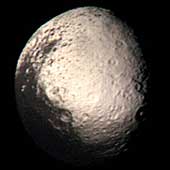|
COMETS EARTH JUPITER KUIPER BELT MARS MERCURY METEORITES NEPTUNE OORT CLOUD PLUTO SATURN SOLAR SYSTEM SPACE SUN URANUS VENUS ORDER PRINTS
PHOTO CATEGORIES SCIENCEVIEWS AMERICAN INDIAN AMPHIBIANS BIRDS BUGS FINE ART FOSSILS THE ISLANDS HISTORICAL PHOTOS MAMMALS OTHER PARKS PLANTS RELIGIOUS REPTILES SCIENCEVIEWS PRINTS
|
Related Document
Download Options
Saturn's outermost large moon, Iapetus, has a bright, heavily cratered icy terrain and a dark terrain, as shown in this Voyager 2 image taken on August 22, 1981. Amazingly, the dark material covers precisely the side of Iapetus that leads in the direction of orbital motion around Saturn (except for the poles), whereas the bright material occurs on the trailing hemisphere and at the poles. The bright terrain is made of dirty ice, and the dark terrain is surfaced by carbonaceous molecules, according to measurements made with Earth-based telescopes. Iapetus' dark hemisphere has been likened to tar or asphalt and is so dark that no details within this terrain were visible to Voyager 2. The bright icy hemisphere, likened to dirty snow, shows many large impact craters. The closest approach by Voyager 2 to Iapetus was a relatively distant 600,000 miles, so that our best images, such as this, have a resolution of about 12 miles. The dark material is made of organic substances, probably including poisonous cyano compounds such as frozen hydrogen cyanide polymers. Though we know a ittle about the dark terrain's chemical nature, we do not understand its origin. Two theories have been developed, but neither is fully satisfactory--(1) the dark material may be organic dust knocked off the small neighboring satellite Phoebe and "painted" onto the leading side of Iapetus as the dust spirals toward Saturn and Iapetus hurtles through the tenuous dust cloud, or (2) the dark material may be made of icy-cold carbonaceous "cryovolcanic" lavas that were erupted from Iapetus' interior and then blackened by solar radiation, charged particles, and cosmic rays. A determination of the actual cause, as well as discovery of any other geologic features smaller than 12 miles across, awaits the Cassini Saturn orbiter to arrive in 2004. (Caption: Courtesy USGS) This image is © Copyright 1999 by Calvin J. Hamilton. Any commercial/for-profit use of this image needs to be addressed to Calvin J. Hamilton. |
||||||||||||||||||||||||||||||||
